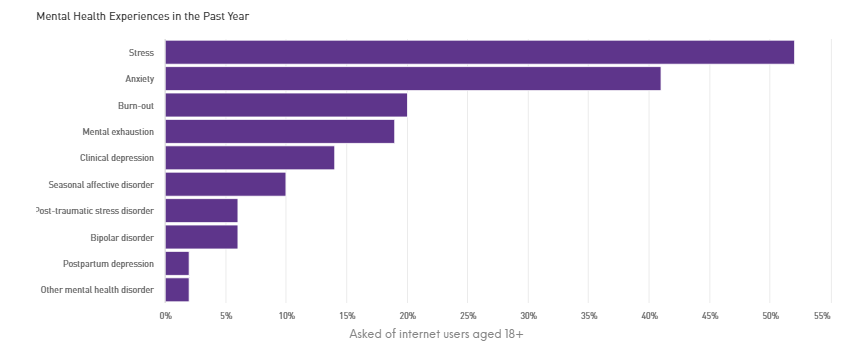Social audience strategies: Investing in mental health
According to Mintel research on mental health and wellbeing, more than three in five Americans acknowledged experiencing stress, anxiety, or clinical depression in 2020, compared to more than two in five in 2019.
These were most common among people aged 18-34, among whom one in two reported experiencing anxiety and one in five reported experiencing clinical depression.

Mental health awareness has become a mainstream topic
Mental illness, an invisible set of disorders that went virtually un-discussed for decades, has gained considerable attention in recent years thanks to the brave individuals who decided to speak up. This led to high-profile celebrities and athletes opening up about their own struggles with mental illness, mainstream media weaving themes into storylines, and brands speaking out in support.
Brands can help de-stigmatize mental illness through cause-based marketing
Cause-based marketing is challenging and sometimes controversial, but it can be effective when strategically planned. There is a never-ending list of causes that brands have supported over in recent years, and often sparked controversy due to the feelings and beliefs of their customers. From Nike‘s campaign featuring Colin Kaepernick on the topic of BIPOC oppression and Pepsi’s infamous “Live for Now” campaign, cause-based marketing is risky, and crafting a meaningful and impactful campaign is no easy feat. It takes confidence to bring an idea to the table, a concerted effort between several key stakeholders within a company and may prove to be costly in both development and execution of the campaign. Once executed, it is nearly impossible to avoid some form of backlash. All things considered, some brands have chosen to remain silent in these conversations.
The problem, however, is that stigma feeds on silence. Every day, people and celebrities started the conversation, brands now have the opportunity to use their extensive reach and powerful brand voices to normalize social issues like mental health.
To run a successful mental wellness marketing campaign, brands need to consider their alliances and intended audience
Be specific
Mental illness is diverse and dynamic. Symptoms and causes of depression and anxiety disorders vary significantly from one person to another. Brands are not expected to speak 1:1 to everyone, but focusing on the issues important to their consumers can allow their efforts to be more targeted and lead to more lasting impacts.
Speak up on Social
In the case of mental health, social media is a double-edged sword. On one side, it’s the easiest place for brands to establish 1:1 connections with consumers. On the other, it is a major source of stress and anxiety amongst young people. Brands can acknowledge this by using their social channels as a place to promote wellness.
Form Meaningful Partnerships
Brands that speak out are expected to back up their statements by taking action. While several charitable organizations exist to aid in mental illness awareness and suicide prevention, brands need to work diligently to not only find organizations that align support their intended audiences but also resonate with their own values.
 Fidelity and TD Bank focused on financial health to spark the conversation on mental wellness
Fidelity and TD Bank focused on financial health to spark the conversation on mental wellness
Being Specific
Instead of targeting a specific group of people, Fidelity and TD Bank focused on how financial health is a factor that plays into a person’s overall mental wellbeing.
Speaking up on Social
Both brands promoted their initiatives on Paid Facebook. Fidelity used Facebook’s lead gen capability to prompt consumers to sign up, while TD Bank directed consumers to a webpage.
Morgan Stanley and Citizens Bank called upon people to nominate mental health non-profits to partner with
 Speaking up on Social
Speaking up on Social
Both Morgan Stanley and Citizens Bank used the sharing power of social media to drive awareness for their mental health initiatives, and solicit nominations from charitable organizations.
Forming Meaningful Partnerships
In recognizing that they were not experts in mental health, Morgan Stanley and Citizens Bank used their financial resources to champion organizations in the mental health space.
By addressing the mental health concerns of their target consumer, these brands crafted outstanding campaigns
Maybelline recognized the negative impact unrealistic beauty standards had on its customers.
 The Campaign
The Campaign
“Brave Together” was launched in 2020 as a program to support those with anxiety and depression. The focal point of the campaign is a micro-site featuring information on mental illness, stories of those affected, and resources to get help. Additionally, Maybelline announced plans to raise $10M for mental health organizations globally.
Why it Worked
The campaign was built around a strategic insight that half of mental health disorders develop by age 14, an age where many young women start using beauty products. By recognizing the potentially negative role it could play in this development, Maybelline created a space to offer help to those who needed it.
If addressing mental health still appears too challenging, consider looking within
COVID-19 brought out intense feelings of anxiety in people around the world, and employers took notice. In the next report of this mental health series, Comperemedia Analysts will unpack the ways in which brands went beyond simple sentiments of support to communicate about newly implemented wellness- and mental health-related initiatives within their organizations.
 Fidelity and TD Bank focused on financial health to spark the conversation on mental wellness
Fidelity and TD Bank focused on financial health to spark the conversation on mental wellness


